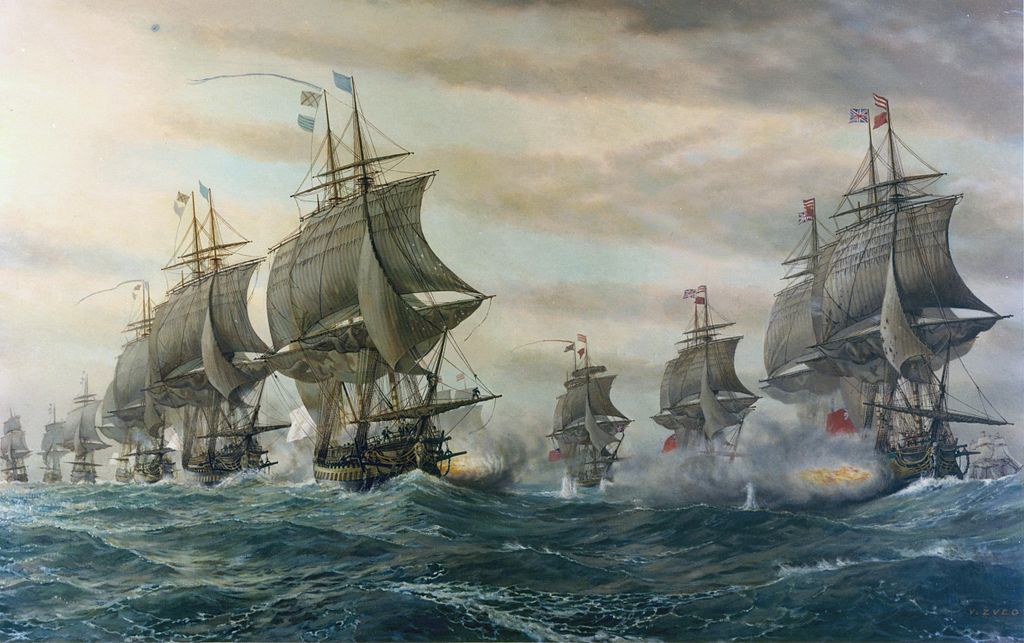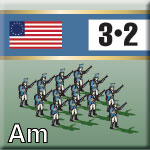The Potato War:
The American War
by Mike Bennighof, Ph.D.
July 2019
 In 1929, historian Arthur H. Buffington apparently coined the phrase “The Second Hundred Years War” to cover the almost-endless series of Anglo-French conflicts that took place between 1689 and 1815. With one exception, the English/British won every one of the wars. In 1929, historian Arthur H. Buffington apparently coined the phrase “The Second Hundred Years War” to cover the almost-endless series of Anglo-French conflicts that took place between 1689 and 1815. With one exception, the English/British won every one of the wars.
During these wars, England/Britain fought as a member of a coalition including at least one continental great power, and sometimes more than one, lending her naval strength when it matched her interests and relying on her allies to fight the massive French army. With greater population and wealth than any of her potential foes, France could easily outmatch any one of them in a land war.
France’s sole victory, what became known as the American War, came about through careful diplomacy that isolated Britain from potential great power allies. The formula for success that had seen the British on the winning side in 1714, 1748 and 1763 included a willingness to fight to the last German. Without an alliance with Prussia or Austria, the British could not hire enough troops from the smaller German states to make up the difference nor would King George III – also the Elector of Hannover – tolerate a threat to the Hannoverian dynasty’s north German homeland.
Consideration of a new war against Britain in case of a revolt in the British American colonies began even as the Seven Years’ War ended. French Foreign Minister César Gabriel de Choiseul predicted a break between Britain and her colonies, and planned to exploit it. To do so, the French could not re-gain their lost territory of New France in Canada – were the provinces back in French hands they would be seen as a greater threat to the American colonies than oppression from London, and drive the Americans back into loyalty to the crown.
 Therefore, Choiseul did not press to retain New France during the 1763 peace talks with Britain, instead choosing to recover the sugar islands of Martinique and Guadeloupe. He did insist on retaining the tiny islands of St. Pierre and Miquelon off the southern coast of Newfoundland as well as France’s rights to fish off the northern coast of Newfoundland, the area known as the French Shore. Choiseul had been willing to give up the sugar islands if necessary to preserve fishing rights there – not so much for the masses of cod dried on the rocky islands of St. Pierre and Miquelon, but as a peacetime training ground for French sailors. The French Navy could not survive without this source of experienced seamen; the French merchant marine did not number nearly enough to make good the shortfall without crippling French trade. Therefore, Choiseul did not press to retain New France during the 1763 peace talks with Britain, instead choosing to recover the sugar islands of Martinique and Guadeloupe. He did insist on retaining the tiny islands of St. Pierre and Miquelon off the southern coast of Newfoundland as well as France’s rights to fish off the northern coast of Newfoundland, the area known as the French Shore. Choiseul had been willing to give up the sugar islands if necessary to preserve fishing rights there – not so much for the masses of cod dried on the rocky islands of St. Pierre and Miquelon, but as a peacetime training ground for French sailors. The French Navy could not survive without this source of experienced seamen; the French merchant marine did not number nearly enough to make good the shortfall without crippling French trade.
With his source of sailors secured, Choiseul next turned to the ships they would man, switching from the Foreign Ministry to the Navy in 1766. He remained there for four years before falling out with Louis XV, laying down dozens of new hulls to replace the massive losses of the Seven Years War. France would have the fleet necessary to challenge the British again, at least in combination with the Spanish.
American ideals of liberty and self-determination found a ready audience in the emerging public sphere in France, the newspapers, cheap paperbacks, coffee houses and salon culture where ideas percolated – helped along by secret government subsidies. The new foreign minister, Charles Gravier comte de Vergennes, saw the predicted opportunity emerge and authorized secret aid to the American rebels as early as 1775. In the spring of 1776, the Americans sent a purchasing agent, Silas Deane, to France where he obtained permission to purchase arms on credit.
 The new young king of France, Louis XVI, saw support for the Americans as an opportunity to seize popular support. French aid increased throughout 1776 and 1777, including delivery of warships and use of French facilities to refit and repair American commerce raiders operating in European waters. Despite the willingness of the king and Vergennes to intervene openly, France hesitated. Vergennes’ refusal to support Austria in the looming crisis over Bavaria and dalliance with Prussia strained the Franco-Austrian alliance, Spain hesitated to commit to support of rebels, and Louis’ navy and treasury ministers warned that France was not ready militarily or financially for a new war. The new young king of France, Louis XVI, saw support for the Americans as an opportunity to seize popular support. French aid increased throughout 1776 and 1777, including delivery of warships and use of French facilities to refit and repair American commerce raiders operating in European waters. Despite the willingness of the king and Vergennes to intervene openly, France hesitated. Vergennes’ refusal to support Austria in the looming crisis over Bavaria and dalliance with Prussia strained the Franco-Austrian alliance, Spain hesitated to commit to support of rebels, and Louis’ navy and treasury ministers warned that France was not ready militarily or financially for a new war.
The American victory at Saratoga in late 1777 brought the French public’s support for the rebel cause to a new peak, and Louis authorized Vergennes to conclude a treaty of alliance, signed in February 1778. That sparked a British declaration of war in the following month, and the American War was under way.
Despite the Navy’s pleadings, both the Brest and Toulon fleets had been mobilized. The Toulon fleet, commanded by Charles Hector Comte d’Estaing, sailed for the New World without British opposition. He briefly blockaded New York in July, attempted a complex operation in Rhode Island in August that had to be abandoned after storm damage, and sailed for the West Indies in November. Meanwhile the Brest fleet fought the British in the western end of the English Channel in August, and the over-stretched Royal Navy attempted to set up a blockade of French ports.

French and British fleets clash off the Virginia Capes.
Spain had begun covert aid to the Americans in 1776, sending powder and shot from their stores in New Orleans and a year later opening Havana for trade with American vessels, including arms and ammunition. The Spanish demurred when asked to declare war alongside France, needing to wind up a colonial war with Portugal, prepare the fleet for operations and shepherd home her treasure fleet from the Americas. In April 1779 the Spanish signed a formal treaty with France outlining joint obligations in a war with Britain. In June the kingdom declared war on Britain and opened siege operations against Gibraltar.
While Vergennes had believed Spanish participation vital to success, he had attempted to keep the Netherlands neutral. Dutch participation, he feared, could spark the wider European war he wished to avoid. Dutch merchants had happily supplied the Americans since the rebellion’s opening days, irritating the British, and facilitated the transport of “naval stores” – rope, tar and timber – from Sweden and Russia to French dockyards. On learning that the Netherlands planned to join the Russian-sponsored League of Armed Neutrality, the British declared war.
In 1779 French operations in the New World saw limited success in North America; the fleet landed 3,000 troops to aid in the American siege of British-held Savannah but failed to capture the port. In the West Indies, the French captured Dominica, St. Vincent and Grenada. War spread around the globe, with the Spanish attacking Gibraltar and French ally Mysore attacking British possessions in India. Spanish expeditions captured British-ruled Baton Rouge and Mobile, but were turned away from Pensacola by a hurricane.
 In 1780 the French finally committed to a ground presence in the American colonies, landing an army in Rhode Island. These troops set out in 1781 to join George Washington’s Continental Army to trap the British at Yorktown in Virginia. The French fleet arrived to isolate the British, while the Spanish raised enough silver in Havana to keep the besieging army supplied. The British surrender effectively ended military operations in the colonies, but not the American War. In 1780 the French finally committed to a ground presence in the American colonies, landing an army in Rhode Island. These troops set out in 1781 to join George Washington’s Continental Army to trap the British at Yorktown in Virginia. The French fleet arrived to isolate the British, while the Spanish raised enough silver in Havana to keep the besieging army supplied. The British surrender effectively ended military operations in the colonies, but not the American War.
Following the success in Virginia, the French fleet sailed to the Caribbean, where the outnumbered British fleet of George Rodney won a major victory at the Battle of the Saintes in April 1782. While Rodney forced the French onto the defensive in the Caribbean, in Indian waters Admiral Pierre André de Suffren inflicted repeated defeats on the British.
By early 1783, the British had lost their colonies and saw no purpose in continued war. A series of peace treaties concluded at Paris recognized American independence and made some minor territorial shifts: France regained Senegal and took Tobago in the West Indies, while Spain recovered the island of Minorca in the Mediterranean from the British and took East and West Florida as well. The Spanish also recognized American claims to all lands east of the Mississippi River, except New Orleans. Dutch interests were essentially ignored by their putative allies.
Vergennes had his victory, and, for a brief moment, Louis XVI became a wildly popular king. Britain had been humiliated, but the overall strategic picture had not changed substantially. France had accrued more than one billion livres in additional debt (total French government revenue in 1780 was 585 million livres), and had granted British desires for peace due to their own inability to finance another year of operations and the massive subsidies granted to the Americans. Vergennes died in 1787, two years before Louis XVI’s efforts to raise taxes to manage that debt (paying it off seeming impossible) sparked a revolution that would ultimately cost him his head.
Click here to order The Potato War.
Sign up for our newsletter right here. Your info will never be sold or transferred; we'll just use it to update you on new games and new offers.
Mike Bennighof is president of Avalanche Press and holds a doctorate in history from Emory University. A Fulbright Scholar and award-winning journalist, he has published over 100 books, games and articles on historical subjects.
He lives in Birmingham, Alabama with his wife, three children and his dog, Leopold. Leopold really is named for Leopold Daun.
|
